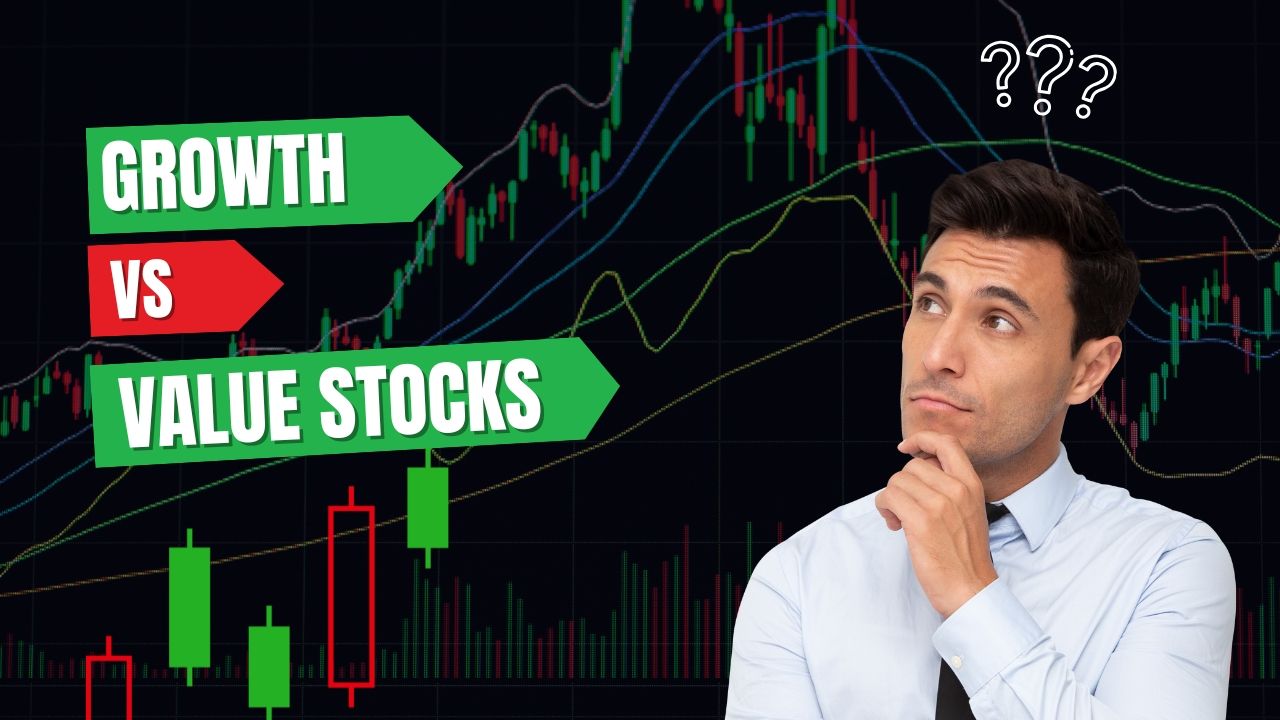Growth or Value Stocks? Find the Perfect Strategy to Boost Your Investment Goals!

Futureincomes.site Happy reading In This Edition I will review success stories related to Stock., Article Reviews About Stock Growth or Value Stocks Find the Perfect Strategy to Boost Your Investment Goals Find important information by reading until the end.
"In the constantly changing world of the stock exchange, each investor faces a dilemma: high flying shares that are growth oriented as opposed to lower priced yet steady shares. This growth value investing intelligent debate has puzzled finance people for years to come and a detailed comprehension about each one of these strategies is very important in coming up with an investment portfolio that is consistent with one’s objectives.
Let’s look at it this way: It’s a busy crossing and you are present at one in the heart of every high-power movement that is the financial sector. On your left you see a contemporary construction in a high place covered by glass this towers skywards. This is about ‘growth stocks’, which are companies that are in growth mode. On your right is an old building which is made of bricks standing firm. This is about value stocks, grown companies that trade less than what they are really worth.
So which one will you go with? The response is never as simple, but by exploring the depths of growth and value investing, we are able to bring out the benefits and limitations of each style practically. From firms with high tech valuations like price to earnings to value creation through strong focus on dividends, we will see how these various styles can bolster or undermine your financial dreams.
So, fasten your seatbelt because we’re going to traverse through growth and value stocks. You will have the tools and knowledge to empower you make future decisions in this investment space. So let’s get started!
What are growth stocks? Surfing The Technological Wave
Compared to the rest of the assets, growth stocks are for the investment heavyweights. Major advances in the growth of these companies are often able to shake up entire industries and take over a large chunk of the market. As a result, growth stocks are the most sought after with investors hoping to make very high returns due to the impressive increase in stock value.
Growth stocks have certain important metrics such as:
Above average revenue and earnings growth rates
Profits are not paid out but instead are spent on further R&D
Penetration of additional geographies or product lines
Market P/E of above average
Almost no dividend payments
A classic example of a growth stock is NVIDIA (NVDA). The enterprise used to deal with graphical processors mostly totaling its development to artificial intelligence and other trends futuristic. That’s the reason for investors to expect NVIDIA’s price to earnings ratios to be above the ballpark on average.
Consider this: In early 2024, while the average price to earnings ratio of the S&P 500 was around 25, the P/E ratio of NVIDIA stood over 100. This mind-boggling valuation is a testament to the cost that investors are prepared to pay for firms that they anticipate will perform tremendously in the future.
The Allure of Growth Investing
The very nature of the assets makes growth investing one designed for people with a relatively calm toleration to risks and a long term oriented investment horizon. The potential for outsized returns comes to the forefront as the quantum of successful growth stocks is such that the returns bear little resemblance to the performance of the stock market as a whole. For example, the Amazon, Facebook (now Meta) and Tesla story have made fortunes to the investors that ventured early in these firms.
But great potential also means great risk. Growth stocks tend to be more volatile than value stocks, and when and if the company doesn’t deliver on high expectations, valuations can drop sharply. Furthermore, in as far as many growth companies are concerned, dividends are not in the picture as they focus on reinvestment instead, meaning that returns will come mainly from capital appreciation.
Value Stocks: Aiming For Aging Frontiers Of The Stock Markets Beyond Growth Investing
The middle of the investment range is value stocks. These are equities belonging to companies which are believed to be trading for less than their actual worth. Like bargain hunters, value investors seek the deals by looking for companies that are currently out of favor in the market but have good prospects for the future.
The features of value stocks include the following:
Lower price to earnings ratios than the market or their sector average
Above average dividend returns
Strong balance sheets with very low debt levels
Consistent although not exceptional earnings growth over time
Pre-existing industries with businesses that are already well established
One classic example of a value stock can be a company like Coca-Cola (KO). This is a company that still does not grow as fast as an emerging tech startup, but has a very stable business model, and is more geared towards paying dividends, which is in line with the valuation of the company.
The Allure of Value Investing
People who are more conservative when it comes to investing in the stock market would most likely be attracted to value investing. With a focus on buying stocks of companies with great fundamentals for cheaper than what it is worth, value investors aim to minimize risks to the downside, whilst at the same time allowing for any potential upside that can arise out of the market coming to recognize the assets as undervalued and seeing them for what they are.
The value approach also means putting a lot of emphasis with regard to generating income by receiving dividends which means that those investors who are looking for steady cash flows from their investments would find it to be to their liking. Such a scenario would be ideal for retirees and those who are close to retirement age as they would look for stability and not aggressive growth.
Historical Performance: Growth vs. Value
The debate between growth and value investing strategies has raged for decades, with each approach enjoying periods of outperformance. To gain perspective on this cyclical nature, let's examine some historical data:
| Decade | Outperforming Strategy | Notable Factors |
|---|---|---|
| 1990s | Growth | Tech boom, dot-com bubble |
| 2000s | Value | Dot-com crash, financial crisis |
| 2010s | Growth | Tech resurgence, low interest rates |
| Early 2020s | Mixed | Pandemic effects, sector rotations |
This table illustrates the cyclical nature of market preferences, highlighting the importance of understanding both strategies and potentially incorporating elements of each into a well-diversified portfolio.
Factors Influencing Growth and Value Performance
A few of the macro and market factors which have an effect on relative performance of growth stock and the value stocks include the following.
1. Interest Rates
The risk-free rate influences the relative attractiveness of growth and value stocks and their valuations. In an environment of low interest rates, growth companies are likely to perform better because investors pay for future feeling. on the other hand, in a high interest rate environment, value firms are likely to attract more investors since earnings and dividends paid currently will be compared with future earnings which will not look as attractive.
2. Economic Cycles
The stage of the economy cycle can also be the reason behind investor to up-trade a strategy over the other one. When the economy is expanding, there is a tendency for growth stocks to be at the lead as the company uses profits generated to reinvest and grow the business further. Growth stocks however tend to perform badly when the economy is on a recession or slow recovery as people shift to value stocks looking for income.
3. Sector Dynamics
There are sectors in the economy that are more dominantly portrayed in growth stocks or in value style. Growth stocks for instance are often domiciled in the technology and biotechnology while value opportunities are dominantly found in utilities and consumer staples. These sectors also help in providing insight on how to traverse the growth-value spectrum when making investments.
4. Market Sentiment
The investor sentiment here is pivotal in determining the performance of growth and value stocks, and it can change in one moment. During bull market phases, growth stocks may perform better as investors may be more aggressive in seeking higher returns. Conversely, during bear markets, value stocks tend to perform better, as investors may prefer to invest more prudently.
Tailoring Your Strategy: Which Approach is Right for You?
Investors are often torn between growth and value investment. There are key personal factors one needs to consider before choosing one or a mix of both, they include:
1. Risk Tolerance
Analyze how much you are prepared to stomach market fluctuations. Growth stocks tend to have larger volatility which may be a headache for the risk hesitant investors. If you are looking for less volatility in performance, then value stocks would be more of your taste.
2. Investment Timeline
Think about the time you are going to dedicate for an investment. Growth strategies would be better suited for investment in stocks for a longer duration of time, since, gains may take longer to appreciate. Value investing can be appropriated for both short and long term strategies based on certain opportunities available.
3. Income Needs
If earning periodic income from your portfolio is more important, then value stock with its greater dividend income may be useful for investors. Growth investors on the other hand have always to depend on sale of appreciated shares for cash flow.
4. Market Outlook
Your view about the wider market and its conditions may automatically inform your strategy. If you feel we are about to experience a rapid growth stage with much disruption, then a growth strategy sounds good. If you feel that the economic condition has headwinds or that the market has excessive volatility, then value tilt may be appropriate.
Blending Growth and Value – A Case for a Mixed Strategy
Most of the time, the proponents of growth and value investment strategies find themselves ordered to two extreme ends of the spectrum – both sides striving to prove that their strategy is the superior. A better solution is to take on a hybrid strategy and blend both approaches. Here are the reasons why such a strategy makes more sense
1. Advantages of Integration
The inclusion of growth and value stocks within the same portfolio allows one to withstand the stock’s overall volatility and seek growth in a bull or bear market. Such diversification can make portfolio returns relatively smoother over time.
2. Opposing Strengths
In most cases, both components in the stock market have their own strengths. Using a balanced portfolio ensures the possibility of multiple markets not just different environments but multiple markets succeeding together.
3. Ability to Include Change
With such a blended approach, investors are now allowed a very great degree of choice on how to spread their wealth across different assets. Some might use expansionary times to focus on growth while using recessionary times to focus on stability.
4. Psychological Comforts
Having both growth and value shares would give a sense of comfort. Use the excitement of growth companies as value investments as stability and it would be easier to stick to the long plan for the return on investment.
Implementing Your Strategy: Practical Considerations
After defining how exactly you would like to approach growth and/or value investing, think along the following lines for putting this into practice:
1. Research and Due Diligence
This is the case regardless of whether one is pursuing growth or value opportunities. In the case of growth stocks, try to comprehend the degree of competitive positioning, market opportunity and growth execution capability of the company. For value stocks, look at the firm’s financials first and its real worth, before finding the triggers for the anticipated market rating.
2. Use ETFs and Mutual Funds
If you are a beginner or would rather not actively participate, growth or value ETFs and mutual funds can be suitable. They are typically used because the defining charts first sort the companies according to stock market capitalisation, price earnings ratios and other financial ratios.
3. Monitor and Rebalance
It is wise to track your portfolio from time to time to reinforce the fact that it is indeed, on the right track with respect to the EMT, that the strategy chosen stands true to the investment aims. As investor sentiment has trends, and trends can be constant with time, sometimes it may take one’s goals further away than intended; adjustments would then have to be made to fit back into the growth-value ratio balances you wish to implement.
4. Be Informed
Find out what is happening with the company and learn the economic indicators and changes in the market that are important for your portfolio. This additional knowledge allows you to be more strategic in your decision on when to buy, hold or sell.
Conclusion: Your Growth or Value Road in the Terrain of Investing
As we have seen in the course of this article, the main issue between the two, growth, and value investing, is not straightforward. Each of the options has its own merits and drawbacks, and what is often referred to as the ‘best’ in should be specific to the requirements of the individual, what the expectations are and how they view the market.
Also, learn to understand that the stock market is not only a competition between growth stocks and value stocks. A number of investors had successes through employing both strategies, and their portfolios are robust in any type of market environment while achieving their financial goals.
Be it growth stocks and their volatile nature that you decide to invest in or whether your investment strategy is inclined more towards looking for undervalued stocks or whether you would like to have a sound mix of both. The most important thing is that you stay within your investment ideology and maintain a long-term view.
As you go about your investment activity, remember that your most important peak resources are adaptability and an ability to learn on the job. The market is most likely dynamic and understanding such aspects such as the historical price to earnings ratio S&P 500 or even the current NVIDIA price to earnings ratio is likely to be beneficial in guiding your decision.
In the end, the investment strategy that is likely to work for you is the one that is easy to follow regardless of the market condition, one that is in tandem of your risk level and financial objectives, and one that also gives you peace of mind when going to bed. Whether it is giving greater emphasis to growth potential or finding great investment opportunities or the combination of both, it is all up to you as a financially empowered individual to secure your future.
This brings us back to the question of a growth versus value approach; as a pithy saying goes ‘do I have to choose between a rock and a hard place.’ Certainly not, and investing is not either or of two scenarios, it is more complex than that. With the knowledge of what you want to achieve out of investing, there should be no limits to how you want to structure your portfolio.
"That's the information about growth or value stocks find the perfect strategy to boost your investment goals that I shared in stock I hope you enjoy reading this article Always stay motivated and healthy. Let's share this kindness with others. hopefully other articles are interesting for you. Thank you.

